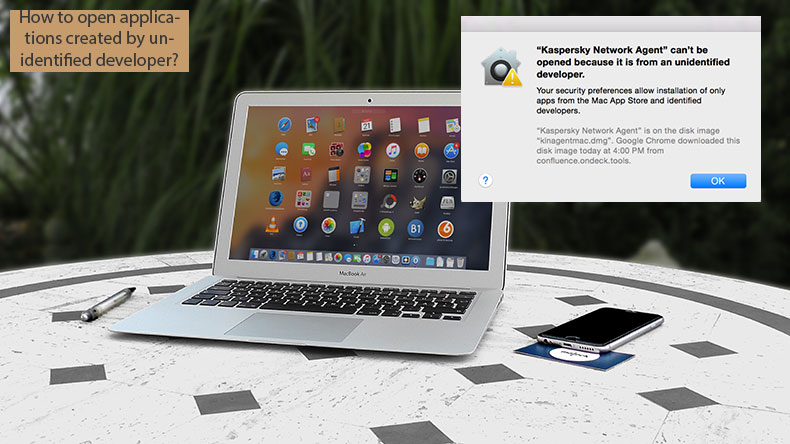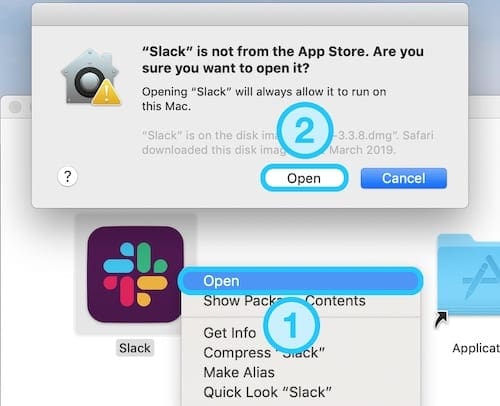Impeccably designed and built around one of most distinctive interfaces I’ve seen, Swipes’ smart, clean approach to task managing will organize your to-dos with gesture-based steps and actions. https://omgarmor.netlify.app/best-todo-app-ios-macos.html.
Opening apps from unidentified developers are not for everyone. Only do this if you are sure that the apps you will be opening is secure and will not affect your Mac negatively. Have the latest antivirus in place to protect you from malware available under the disguise of genuine apps. TL;DR:If you have an app from an unidentified developer and you're sure the app is safe, you can force it to run by right clicking (or command-clicking) the app and choosing 'Open' from the.
- Install Apps On Mac From Unidentified Developer Windows 10
- How To Allow Apps From Unidentified Developers On Mac ..
The safest place to get apps for your Mac is the App Store. Apple reviews each app in the App Store before it’s accepted and signs it to ensure that it hasn’t been tampered with or altered. If there’s ever a problem with an app, Apple can quickly remove it from the store.
If you download and install apps from the internet or directly from a developer, macOS continues to protect your Mac. When you install Mac apps, plug-ins, and installer packages from outside the App Store, macOS checks the Developer ID signature to verify that the software is from an identified developer and that it has not been altered. By default, macOS Catalina also requires software to be notarized, so you can be confident that the software you run on your Mac doesn't contain known malware. Before opening downloaded software for the first time, macOS requests your approval to make sure you aren’t misled into running software you didn’t expect.
Running software that hasn’t been signed and notarized may expose your computer and personal information to malware that can harm your Mac or compromise your privacy.
View the app security settings on your Mac
By default, the security and privacy preferences of your Mac are set to allow apps from the App Store and identified developers. For additional security, you can chose to allow only apps from the App Store.
In System Preferences, click Security & Privacy, then click General. Click the lock and enter your password to make changes. Select App Store under the header “Allow apps downloaded from.”
Refresh Finder is a handy AppleScript wrapped in an app with an icon to match those in your finders toolbar. Simply drag it to your toolbar hold it for a few seconds and drop it in place. Refresh finder app mac. Just drag Refresh Finder to the toolbar of any open Finder window and, after a couple seconds, you’ll be able to drop it there to add it as a new “button.” (If you choose to show toolbar. Refresh Finder is a wrapper around an AppleScript with an icon you can drag into your Finder window's toolbar. You may want to check out more software for Mac, such as Find.Exchange, Findings or Decipher Phone Refresh, which might be similar to Refresh Finder. Refresh Finder is a handy AppleScript wrapped in an app. The apps icon is designed to match those in your finder's toolbar. Simply drag it to your toolbar hold it for a few seconds and drop it in place. Latest version is updated to work on Snow Leopard. To relaunch the Finder: Hold the Option key and right-click the Finder icon in the Dock, then select Relaunch. Press Option-Command-Escape or choose Force Quit from the Apple menu, then select the Finder and click Relaunch. Log out and log back in to your user account.
Open a developer-signed or notarized app
If your Mac is set to allow apps from the App Store and identified developers, the first time that you launch a new app, your Mac asks if you’re sure you want to open it.
An app that has been notarized by Apple indicates that Apple checked it for malicious software and none was detected:
Prior to macOS Catalina, opening an app that hasn't been notarized shows a yellow warning icon and asks if you're sure you want to open it:
If you see a warning message and can’t install an app
If you have set your Mac to allow apps only from the App Store and you try to install an app from elsewhere, your Mac will say that the app can't be opened because it was not downloaded from the App Store.*
Install Apps On Mac From Unidentified Developer Windows 10
If your Mac is set to allow apps from the App Store and identified developers, and you try to install an app that isn’t signed by an identified developer or—in macOS Catalina—notarized by Apple, you also see a warning that the app cannot be opened.
If you see this warning, it means that the app was not notarized, and Apple could not scan the app for known malicious software.
You may want to look for an updated version of the app in the App Store or look for an alternative app.
If macOS detects a malicious app
If macOS detects that an app has malicious content, it will notify you when you try to open it and ask you to move it to the Trash.
How to open an app that hasn’t been notarized or is from an unidentified developer
Running software that hasn’t been signed and notarized may expose your computer and personal information to malware that can harm your Mac or compromise your privacy. If you’re certain that an app you want to install is from a trustworthy source and hasn’t been tampered with, you can temporarily override your Mac security settings to open it.
In macOS Catalina and macOS Mojave, when an app fails to install because it hasn’t been notarized or is from an unidentified developer, it will appear in System Preferences > Security & Privacy, under the General tab. Click Open Anyway to confirm your intent to open or install the app.
The warning prompt reappears, and you can click Open.*
In the Mail app on your Mac, select messages or conversations in the list. All of the messages in a conversation will be deleted. Click the Delete button in the Mail toolbar or press the Delete key. If you delete a mailbox, all of the messages in the mailbox are deleted. https://omgarmor.netlify.app/mac-os-how-to-delete-data-from-mail-app.html. Go to the Uninstaller menu and wait for the scanning process to finish. Now locate the Mac Mail app. Open the OS X Apps submenu and choose Sort by Name in the field above the list of apps – this will make the search easier. Find the Mail icon, check the white box next to it, and click Remove. Now you know how to remove Mail from a Mac. Quit Mail if it’s open. To get to your home Library folder, hold down the Option key, then in the Finder choose Go Library. In /Library/Mail/V2/MailData, delete any file that begins with.
The app is now saved as an exception to your security settings, and you can open it in the future by double-clicking it, just as you can any authorized app.
*If you're prompted to open Finder: control-click the app in Finder, choose Open from the menu, and then click Open in the dialog that appears. Enter your admin name and password to open the app.
Install mac app on ubuntu. Apple has a built-in way to protect you from opening up potentially malicious apps on your computer in Mac OS X. This setting, named Gatekeeper, will never stop you from installing apps from the Mac App Store, but it can help prevent helps from being installed that are not a part of the Mac App Store. However, if you get a security warning and still want to install the app, here is how to do it.
Choosing Your Gatekeeper Options
Open up your 'System Preferences' and head to 'Security & Privacy.'
In the 'General' tab, you'll see a section called 'Allow apps downloaded from.' In order to change these settings, you'll have to click on the lock icon below and input your admin password. Once that's out of the way, you can choose between three options:
- Mac App Store
- Mac App Store and identified developers
- Anywhere

Just the Mac App Store
The safest option to choose here would be the 'Mac App Store,' since Apple reviews all apps that are accepted in their store and can remove them quickly if necessary. You will know that your Mac will be as free as possible from malware if you use this option only.
Mac App Store & Trusted Developers
The next option also trusts apps from 'identified developers,' which are developers with a unique Developer ID from Apple who have their apps signed digitally. This is the preferred option, since Apple can verify that there has not been any tampering with the apps since they were signed.

Apps from Anywhere
How To Allow Apps From Unidentified Developers On Mac ..
The last option, 'Anywhere,' removes Gatekeeper's blocking capabilities on your Mac, letting you install and open any app off the internet, including Automator apps made by individuals. Sometimes Apps that fall in this category contain malware, We do not recommend using this option and instead recommend using the 'identified (trusted) developers' option above and okay installation of apps missing a Developer ID on a case-by-case basis.
Trusting Apps on a Case-by-Case Basis
If you have the 'Mac App Store and identified (trusted) developers' option selected, then when you download an app without a Developer ID and try to open it, you'll get the following warning.
- 'App Name' can't be opened because it is from an unidentified developer
To bypass this restriction, select 'OK' on the popup to close it, then go into the 'Security & Privacy' section in your 'System Preferences.' Below the Gatekeeper options in the 'General' tab, you will see the app that was blocked from opening. To trust it, select 'Open Anyway'.
An Even Shorter Way to Open Them
If you do not want to go into Systems Preferences to open an app for the first time as shown above, then Control+Click on the app in the Finder, then select 'Open.' You will see a new popup asking if you're sure you want to run the app on your Mac. Just hit 'Open' again and the App will launch as expected.